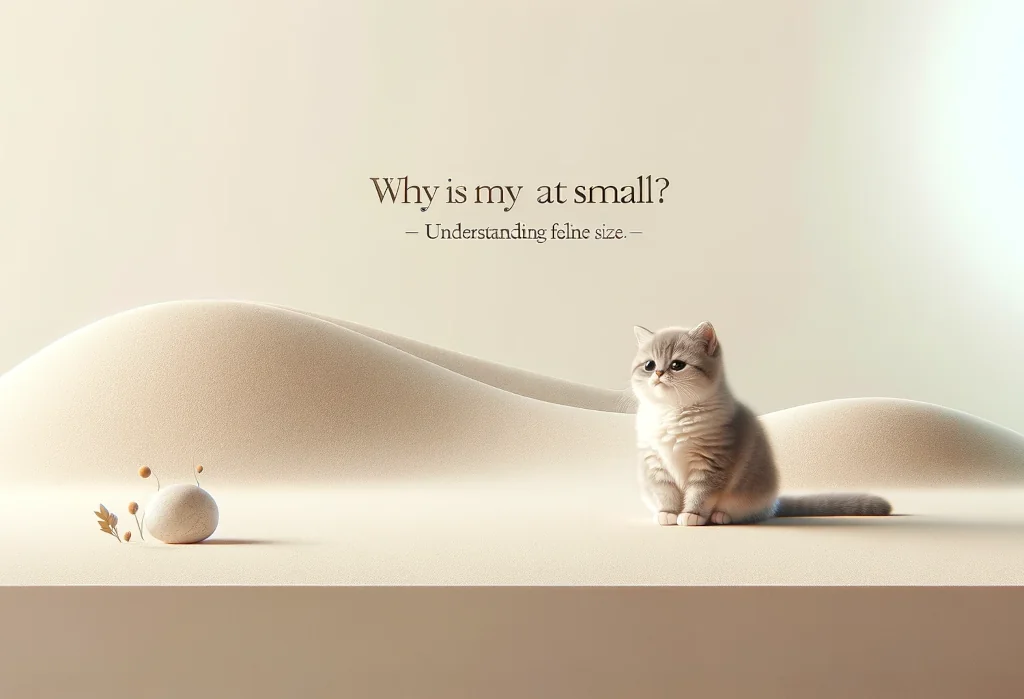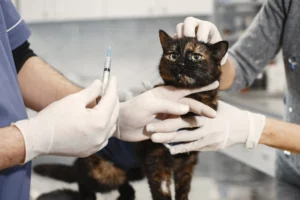Cats come in all shapes and sizes, and yours has decided that being fun-sized is the way to go. While sheer curiosity might have you scratching your head (and theirs), wondering if this pint-sized nature is normal, it’s the love for these tiny furballs that has us all asking, “Should I be worried?”
By the end of this post, you’ll have a clearer understanding of what might be influencing your cat’s modest stature and if it’s a cause for a vet visit or just a unique trait to adore.
Quick Takeaways:
- Your cat’s petite size could be rooted in genetics or breed, with some like the Singapura naturally small but healthy.
- Diet quality, especially protein source, plays a crucial role in supporting your cat’s growth and overall health.
- Regular vet visits are key to distinguishing between a cat’s natural size and potential health-related growth issues.
Is Your Cat Naturally Small?
Ever looked at your feline friend and wondered, “Why is my cat so small?” Well, you’re not alone. But let me tell you, sometimes the answer lies in their very essence—their genetics and breed. Just like people, cats come in all shapes and sizes. And yes, some breeds are naturally on the petite side. Take
the Singapura, for example, known as one of the smallest cat breeds, they are naturally small but perfectly healthy. Then there’s the mix-breed magic; with a mixed-breed cat, you’ve got a unique blend of genetic traits that can result in a smaller-than-average size, which is absolutely normal.
Diet and Nutrition: Are They Getting What They Need?
Now, let’s chew on something quite important—your cat’s diet. Proper nutrition is the cornerstone of a healthy life, especially for your little carnivores.
Cats need a balanced diet rich in proteins and fats to fuel their growth and maintain overall health. But here’s a nibble of advice that’s often overlooked: the quality of protein matters. It’s not just about feeding them enough; it’s about feeding them right. For example, incorporating a high-quality wet food diet can support better hydration and provide essential nutrients more effectively than some dry foods.
Keep an eye out for any signs that their diet might be off the mark – dull coat, lack of energy, or problems with weight. These could be red flags that something in their nutrition needs tweaking.
Health Check: When Small Size Might Indicate a Problem
Sometimes, though, the issue might run deeper than diet. There’s a thin line between a naturally small cat and one that’s small due to health issues. Conditions such as thyroid problems, parasites, or genetic disorders can stunt a cat’s growth. But don’t jump to conclusions just yet—regular vet check-ups can catch many of these issues early on.
A unique piece of advice? Pay attention to your cat’s dental health. Poor dental health can lead to significant health problems that affect more than just their mouth and can impair their ability to eat properly, thereby affecting their overall growth and health. It’s a detail that’s easily missed but crucial for their well-being.
Remember, while this section wraps up our discussion on why your cat might be small, the journey to understanding and nurturing your petite companion doesn’t end here. Keep your eyes peeled for more insights and tips on ensuring your tiny tiger lives a big, healthy life.
Growth Patterns: What Can You Expect?
Cats, much like little whirlwinds of fur, follow their unique paths to adulthood. It’s fascinating to watch them grow, but sometimes you might find yourself puzzling over their size and development. What’s the scoop on kitty growth spurts, and when do they hit the brakes? Let’s dive in.
From the moment they’re born, kittens embark on a rapid growth journey, hitting various milestones along the way. For the most part, cats continue to grow until they are around 12 to 18 months old. However, this can vary significantly based on the breed. Large breeds, such as Maine Coons, may not fully mature until they’re around 3 to 5 years old!
Here are a few nuggets of info to keep in mind when tracking your cat’s growth trajectory:
- 2-4 Months: Expect your kitten to be all kinds of playful, with a significant growth spurt. This is a crucial time for social development too.
- 6-12 Months: This period often marks the onset of puberty, and while growth may start to slow, your cat may continue to fill out.
- 1-2 Years: For most cats, this is when they reach their adult size. However, they may continue to develop muscle and fill out.
If your cat seems smaller than its peers, remember that genetics, nutrition, and health play pivotal roles in determining size. Some cats are simply smaller due to their genes. However, if you’re concerned your feline friend isn’t hitting their growth milestones, consult your vet to rule out any health issues.
How Can You Support Your Cat’s Health and Happiness?
Ensuring your pint-sized pal lives their best life involves a mix of love, care, and understanding what makes them tick. Here’s how you can turn your home into a feline paradise, fostering health and happiness every step of the way:
-
Nutrition is key: A balanced diet tailored to their life stage is crucial. High-quality kitten food is essential for growth, while adult cats benefit from a diet that maintains their health without leading to overfeeding. Don’t forget to keep fresh water available at all times!
-
A stimulating environment: Cats are natural explorers and hunters, so a home filled with toys, climbing trees, and safe spaces to hide keeps them mentally and physically engaged. Interactive toys or puzzle feeders can also stimulate their brains, keeping them sharp.
-
Regular vet check-ups: Prevention is better than cure. Regular visits to the vet for vaccinations, check-ups, and dental care can nip potential health issues in the bud.
-
Comfort is king: Cats love their comfort. Ensure they have a quiet, cozy place to retreat to for those important cat naps. This might seem simple, but a well-placed bed in a quiet corner can be a haven for your furry friend.
-
Respect their space: Cats are known for their independence. They appreciate interaction on their terms. Learning and respecting your cat’s boundaries can significantly enhance their happiness.
Here’s a unique tip you might not find everywhere: Create a ‘catio’ or safe outdoor enclosure. This allows your indoor cat to enjoy the outside world without the risks associated with roaming freely. It’s a fantastic way for your cat to get fresh air and stimulation while staying safe.
Remember, every cat is unique, and what works for one may not work for another. Observing and responding to your cat’s individual needs and preferences is the key to a happy, healthy life together. Whether your cat is big, small, or anywhere in between, they’re a cherished member of your family deserving of all the love and care you can give. After all, it’s not the size that matters—it’s the boundless joy and companionship they bring into our lives.
Alex, a passionate animal lover, has experience in training and understanding animal behavior. As a proud pet parent to two dogs and three cats, he founded AnimalReport.net to share insights from animal experts and expand his knowledge of the animal kingdom.





